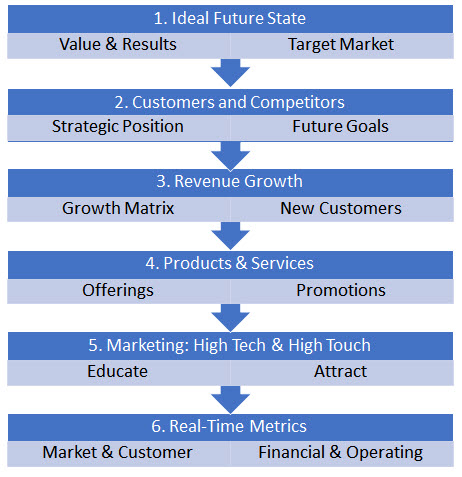Someone recently asked me why I give away so much of my content for free. My answer is for the same reason great photographers share their tips online on how they took the photos. Great photos are a combination of artistic talent and technical skill. Those are the same skills involved in strategy development and execution, as well.
I’ve talked about my Six Hour Strategy® model recently and some of the major steps. Here is the full model.
Figure 8.1

The major steps include:
- Identifying your ideal future state. This is not done by projecting from where you are now. It’s about creating your ideal future business based on the value and results that you create for your ideal target market.
- Customers and competitors both have strategic positions and future goals. You can ask your customers what theirs are and help them to achieve more. You can discern what your competitors are up to and assess your opportunities in the market.
- Revenue growth is usually the top goal for many mid-market companies, and it should be. Revenue growth comes from creating new products and services to sell to your existing customers, or selling your existing products and services to new customers. You can’t do both at once and need to pick one strategy first.
- Products and services are what your customers buy from you to achieve their results. Make sure your products and services are promoted based on their results (benefits) and not solely on their technical features or, worse, the price. If you’re competing on price alone, you’re a commodity, and your days are numbered. Price is important, but it’s not the value proposition.
- Marketing informs your target market about your value and results. It gets the phone to ring or the email to ping in the form of inquiries. Converting these leads to sales is the next step. Your speed of response to the inquiry gives you the advantage here.
- Metrics help you measure and evaluate progress in real-time so you make quick adjustments and take advantage of slower competitors and hungrier customers. Your implementation plan is tied to your metrics and timelines. These drive accountability and performance.
As kids playing street hockey, we always kept score. Too often, I see businesses with sophisticated accounting systems that are terrible at keeping score of what happens every day in their businesses. They need a flash report to record sales, production, and cash flow. That’s how you hold everyone accountable for results. That’s a great indicator of an effective strategy: you can measure it!
If you can’t measure your strategy, you’ve likely wasted a lot of time and money developing a fancy binder and tricking your brain—and business—into a false sense of security.
Those are my high level descriptions for the six steps that will enable you and your executive team to create a strategy and implementation plan in one day.
Rome wasn’t built in a day. But your strategy definitely can be!

